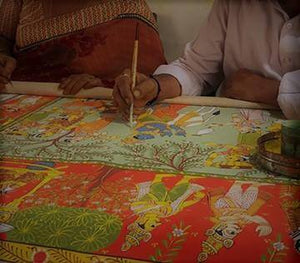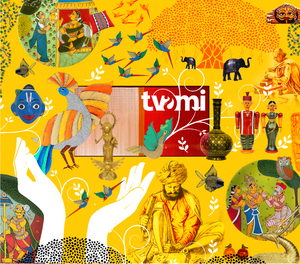Cheriyal Paintings
Filters
- Out of stock Remove filter
- Clear all
- Out of stock Remove filter
- Clear all
There are no products matching your search
View all productsThe background | Cheriyal Paintings and Scroll Paintings
Scroll paintings in India have, in the past, played an essential role in the narration of stories and the imparting of traditional knowledge, usually by balladeers and village bards. Cheriyal scroll paintings, which originated in Cheriyal, present-day Telengana, similarly illustrate the region’s folklore and traditions. Having origins that date back to as far back as 1625 AD, Cheriyal paintings and Cheriyal scroll paintings were solely practised by members of the Nakashi tribe. The paintings were initially used to educate those who could not read and were a significant part of storytelling. Today, they are still utilised for the same purpose and have become a more tangible way for the Nakashi tribe to preserve their heritage.
The theme | The focus of Cheriyal Paintings
Cheriyal paintings are vibrant and eye-catching, focusing on a variety of themes, including mythology, social structure, nature, and legends of heroes. The last one varies from community to community.
The ingredients | The prerequisites for a Cheriyal Painting
The artform uses natural fabric and colours, with the canvas being made of khadi. The khadi is treated with tamarind seed paste, rice starch, tree gum, sawdust, and white mud to make it firm. The colours are acquired from natural sources such as seashells, charcoal, turmeric, indigo, and other stones and vegetable dyes.
The method | Preparing the Cheriyal Painting
The process of creating a Cheriyal painting, like most ancient artforms, is a long one. First, the canvas is prepared, as mentioned in “The ingredients” section above. This process usually takes a few days. Once the canvas is ready to be used, the artisans start the drawing process, lightly hand-drawing the visuals before giving them a sharper, darker outline with a brush. After the outline, come the natural colours. Artisans would fill colours based on the theme of the paintings and the stature of the figures. Gods and goddesses were often represented in blue and yellow, respectively, while human beings were often painted in pink. Demons were allotted darker hues like brown. Once the colouring was done, varnish in the form of tree gum water was used to preserve the artwork.
The present | Cheriyal Paintings today
Cheriyal paintings and Cheriyal scroll paintings received the GI Tag in 2007 and are considered an integral part of India’s heritage. This ancient artform has, however, gone through a few logistical changes. Paintings and scrolls that were once 60 feet long and meant for grand homes have now become smaller and shorter. Narratives have gone from a full story to a few scenes. This is, of course, expected since the size of homes is getting smaller and the available area for these paintings to be displayed is reducing. In order to meet changing real estate circumstances as well as modern-day aesthetic demand, artisans who create Cheriyal paintings have switched from creating Cheriyal scroll paintings that are 60 feet long or more to those that are only 2 to 3 feet in length. Does this impact the quality of output? No. Does this impact the story being told? Only slightly. This is because the artisans have expertly adapted to the limited canvas space and are using their imagination to tell narratives of the past and present within only an image or two. However, we must say, we do envy those who have yards of stories draped across their walls as each step they take guides them into another realm and another era.


